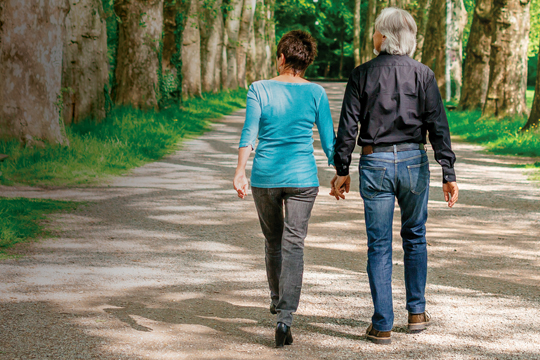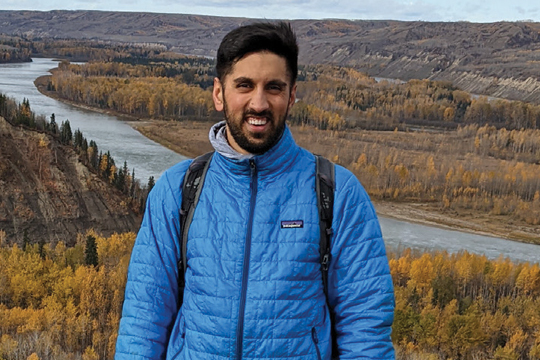
PaRx, a British Columbian project that is spreading across Canada, wants doctors and health practitioners to give their patients prescriptions for time in nature. This winter, it announced a collaboration with Parks Canada.
Does an amble a day keep the doctor away?
The answer can be yes, as part of a healthy lifestyle, and a British Columbia project that is spreading across Canada wants doctors and other health professionals to give their patients prescriptions for time in nature.
“What we’re trying to do is make nature seen as the fourth pillar of health, just as important as diet, exercise and sleep,” says Melissa Lem, a family doctor in Vancouver and director of PaRx, the project co-founded by Lem and the B.C. Parks Foundation. As the program has expanded to Saskatchewan, Manitoba and Ontario, more than a thousand health professionals have signed up with PaRx to write nature prescriptions. “It’s a really important part of preventative medicine.”
It may seem obvious that getting outdoors and moving more is good for you, but most people don’t realize just how good for you nature can be.
“Nature’s so powerful that just looking at it can improve our health,” Lem says. A growing body of research shows that being in nature can help alleviate chronic diseases, and improve respiratory and cardiovascular health and immunity.
Lem says a 2018 meta-analysis shows that time in nature has “a wide range of positive physical effects, from reduced risk of diabetes to better blood pressure to better cholesterol to better cancer outcomes, and to better prenatal health and birth outcomes.”
Melissa Lem, a family doctor in Vancouver, is the director of PaRx, a program that advocates for nature prescriptions and has expanded from B.C. to Saskatchewan, Manitoba and Ontario.
A broader trend of “social prescribing” is growing in Canada, as seen at art galleries such as the Musée des beaux-arts in Montreal. It brings in seniors, teens and others to help with mental and emotional health by seeing and considering art. In Ontario, The Toronto Star recently reported on how “close looking” at fine art can “help reduce burnout in COVID medical workers. The growth of “green social prescribing” is backed with data-based research around the world.
The U.K.-based Guardian news service recently featured people who cite simple time in nature as a major factor in their recuperation. “If you can just be quiet, you can find your balance again,” said Wendy Turner, who, during the pandemic had lost her job, her home and even her will to live. She attempted suicide in 2020. Her recovery benefited greatly from a few hours a week in a nearby salt marsh, Turner said. “It sounds dramatic, but this place saved my life.”
Other researchers in the U.K. and elsewhere are establishing that regular contact with nature — even inside cities — can greatly reduce feelings of loneliness, which improves overall health. Using an app called Urban Mind, they gathered data from around the world, including from users in Canada — from Prince Edward Island to Vancouver Island. The movement has such growth that The Globe and Mail’s list of “health and fitness trends to watch in 2022” included “leaning in to the power of nature.”
Peter Singh, a third-year medical student at the University of British Columbia, was so struck by his own experience with the healing power of nature that he volunteered to help establish PaRx. “I can speak to both sides,” Singh says.
In 2014, he was “kind of bitter” that he had to move back to the hometown — Surrey — that he’d spent so much energy trying to leave. But his father had been diagnosed with ALS, and Singh was needed to help provide care. He found an outlet for his resentment in running — but not on a treadmill or on nondescript city streets.
“I found myself running through forests, and it was so much more mentally stimulating than running through city blocks. I found a lot of solace in that,” Singh recalls. His father died of “this cruel disease,” and not long after, his mother had a cancer scare, and Singh found himself going back into the forest to deal with the loss and pressure.
“Everything around you is flourishing and life goes on, and it’s hard to feel (negative),” he says. “It’s really nice to have this reminder.”
Medical student Peter Singh started promoting the healing power of nature when he had his own experience dealing with his parents' health issues.
Not everyone is able to go running, or even walking, in forests, and access is a key issue for health professionals to consider as experience and research grow, says Anna Cooper Reed. The Winnipeg-based social worker is a PhD student in health services research at the University of Toronto, and is launch co-ordinator (with Angie Woodbury) for PaRx in Manitoba.
“It’s harder to access nature when you’re living downtown in a highrise,” says Cooper Reed, who works primarily with geriatric patients, where mobility problems are more common. “When we talk about nature prescribing, we should also consider the equity issue, and if it’s something that’s actually accessible to everyone.” It could even be a park downtown, she says, if that’s what the patient and their health professional decide is the best option.
“One thing that’s important about nature prescribing is that it’s meant to be a conversation between the prescriber and the patient, and everyone has a different way of connecting to nature, and feeling the benefits of that.”
Skeptics might ask why that conversation requires a written prescription, but that idea too is bolstered by research — and a bit of common sense, Lem says.
“Research tells us that when you write something down, it increases the likelihood a patient will actually do it, and increases their motivation,” she says, and adds a practical point. “When I want a patient to remember something, I write it down. That reminder and that making it more formal makes patients perhaps take it more seriously.”
Green social prescribing has itself had to push to be taken seriously by many, and continues to do so with the growing body of research. Those data-backed findings give the practice credibility with potential funders, be they government sources or others. PaRx, which is funded by the B.C. Parks Foundation, has received a grant from the Canadian Medical Association, and displays an impressive list of “partners and endorsers” on its website, including provincial medical associations, university medical faculties, nurses’ associations and others.
“In order for it to be funded, in order for science-based health professionals to get behind it, it needs to be backed up by research,” Lem says. “There is this four-decade body of research that’s growing about the health benefits of nature.”
It’s possible that regular, frequent contact with nature — PaRx recommends two hours weekly, in blocks of 20 to 30 minutes — could improve health outcomes and reduce spending in other areas of health care. Cooper Reed stresses that green prescribing is not a replacement for other vital areas of health care, but is a complement.
“This isn’t to take away from other people’s practice and what they’ve been doing,” she says. “I think we’re introducing something that can potentially make medicine more holistic, and supplement things like medication.”
Lem says PaRx currently has teams working on expansions to Alberta and Quebec, others “making inroads” in Atlantic Canada and in the Canadian north, and she hopes the organization will be national by end of 2022. “PaRx was always meant to be a national initiative even though it’s powered by the B.C. Parks Foundation,” she says.
Cooper Reed adds that regardless of whether PaRx is working yet in your area, patients can raise the idea of nature prescribing with their doctor or other contact in health care.
“I often tell people, bring it up with your health-care provider. Just because they don’t bring it up, doesn’t mean you can’t bring it up.” It could be with your doctor, nurse, pharmacist, therapist or social worker — anyone who is licensed in health care.
Meanwhile, the PaRx website (parkprescriptions.ca) has free resources available online to help patients improve their health with nature — and to help heal nature itself.
“There is research showing that when people are more connected to nature, they’re more likely to protect it, which makes sense,” Lem says. “I like to feel that when I write a prescription for nature I’m doing my little part for the planet.”



